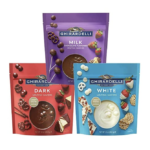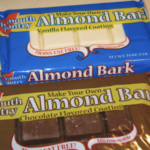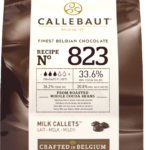Let’s talk about choosing chocolate!
As a professional chocolatier, I use something called ‘couverture chocolate.’ This is chocolate that is made with at least 31% cocoa butter, and when tempered, produces a finished product that has a gloss, a snap when broken, a smooth mouthfeel and doesn’t produce bloom – or white streaks on the chocolate. In the industry, this is known as ‘fine chocolate.’
While this is the best chocolate you can use for this course, it is expensive and you might not be ready to invest a lot of money into a chocolate that your child or teenager will be practicing with.
There are other options which do not require tempering, but will work by melting in the microwave or on the stove.
Here are some of these more affordable options:.
 Meltables
Meltables
You can find meltables such as Ghiradelli disks in large grocery stores or online. Ghiradelli makes meltables in dark, milk and white. As the name suggests, these are made to melt and work well in the microwave. I recommend these above chocolate chips because they are made to melt easily and above almond bark because they are made with chocolate (while almond bark isn’t).
 Almond Bark
Almond Bark
Even if almond bark looks like chocolate, it isn’t. Just look in the ingredients – you won’t see chocolate listed. But your child can still practice with this low cost option. Just melt in the microwave or on the stove top and get to work. You don’t get the great chocolatey taste we all love, but it will give you an affordable option to practice with. I recommend almond bark above chocolate chips because it’s made to melt easily.
 Chocolate Chips
Chocolate Chips
Brands such as Nestles or Ghiradelli can be found in most grocery stores and can work for this course. But when melting you have to be careful that you don’t let them burn – esp. in the microwave. These chips don’t contain enough cocoa butter to temper so once the chocolate sets – or hardens – you may see a streaked appearance. This is called bloom and occurs when the chocolate solids separate from the cocoa butter. It’s safe to eat – just a bit unattractive.
This is real chocolate, will probably taste familiar to your child, and is affordable. But it will be harder to work with than Meltables or Almond Bark.
Fine Chocolate
Of course, if you can afford it, or if you want to try it once you’ve mastered some of the skills in the course, I recommend using fine chocolate such as Callebaut, the Belgian brand of chocolate I use in my business. The Callebaut recipes I use are 811 for milk and 823 for dark. You can find these on Amazon.
You’ll learn more in the module on tempering but just remember that learning to temper chocolate can be tricky and may require practice. And as long as you don’t burn the chocolate by heating it over 115 degrees Farenheit, you should be able to use it again as you practice the art of tempering.
Also, be sure to look on the packaging of the chocolate you purchase for the specific temperatures for melting and cooling the chocolate. Different chocolates can require different temperatures for melting and cooling – so it’s very important to stay within the temperatures the manufacturer recommends.
I hope this helps as you consider which chocolate you’d like to use.
If you have any questions, please feel free to email me or reach out in the private Facebook group.
